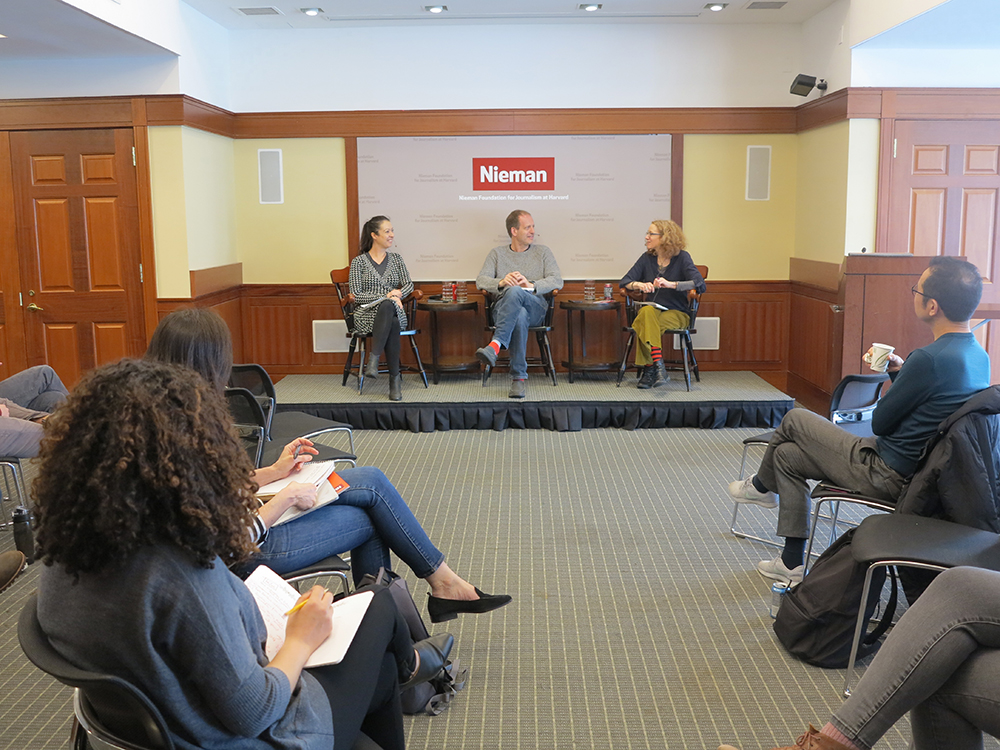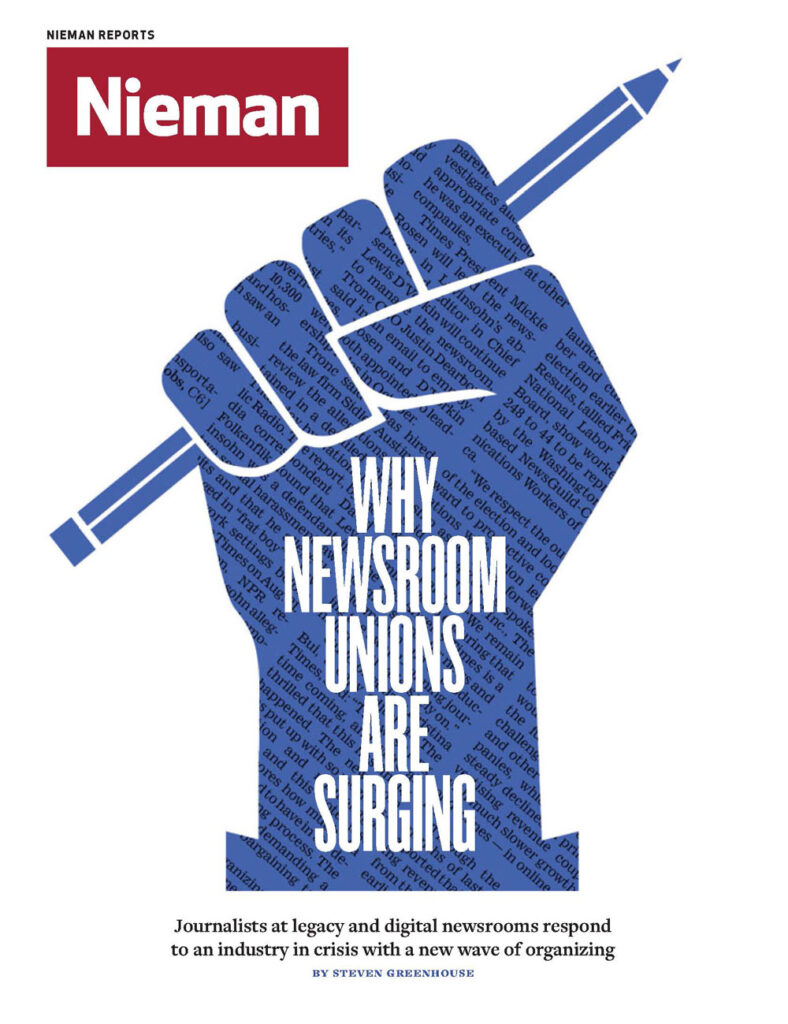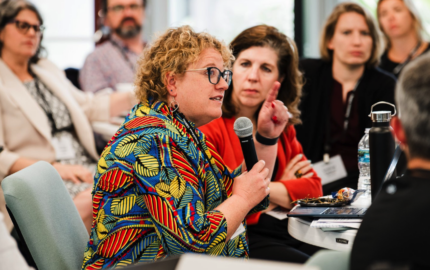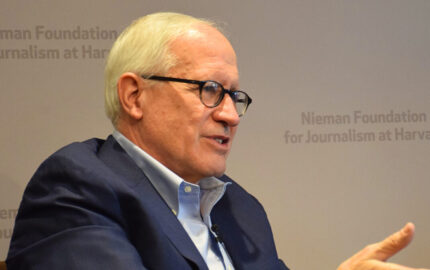Not only did Edison Research’s Infinite Dial report underscore that podcasting has gone mainstream but big money has followed. Podcasting startup Luminary announced $100 million in funding and plans to offer subscriptions in its effort to be the Netflix for podcasting. Over the past year Spotify increased the number of podcasts it offers and earlier this month the music streaming service acquired podcast company Gimlet Media.
To make sense of these developments and to discuss podcasts by journalists, 2019 Nieman Fellow Francesca Panetta, who early on led The Guardian’s podcasting team, brought together Jake Shapiro and Julie Shapiro (no relation to each other) for a conversation. Jake Shapiro is co-founder and CEO of RadioPublic, a mobile listening platform and marketplace for podcasts that was spun out of media company PRX. It is an app and a curated offering of podcasts.
Julie Shapiro is executive producer of Radiotopia from PRX. She also is executive producer of “Ear Hustle,” a podcast that tells stories from within San Quentin State Prison in California. A fan of the list genre of podcasting, she named two favorites: WNYC’s “10 Things That Scare Me” which features both well-known and ordinary people (“this collective tapestry of our national mentality right now,” she called it) and “An Inventory of Philando Castile’s Car” (an “enormous portrait of this man through the things in his car”), an episode of Minnesota Public Radio’s “74 Seconds” about the killing of Castile by a police officer.
Panetta started with the business side of podcasting: “Is it a bubble waiting to burst?”
Edited excerpts:
On the state of business
Julie Shapiro: Fifty-one percent of people know what the term “podcast” means, which is more than when Edison Research counted last year. When you look at these trends, you look at the money coming in, you look at the excitement, and you look at the creative energy in the space, the indication to me is, no, we're not in a bubble that’s going to burst. The bubble is getting bigger, but not bursting.
It’s harder and harder for individuals to puncture through the noise and have a show that has enough listeners that you can support yourself, whether you’re listener‑supported through Patreon or you’re big enough to start getting ads.
There are technologies and companies like RadioPublic that are trying to make it possible for every podcaster to earn money. But what is mostly happening is lots of money going to big companies that have huge staffs, huge budgets, and investment money. There’s the world of public radio—talent, and mission‑driven communities that started podcasts at stations—and there’s the more commercial side that is working with more business-y models and venture capitalists
Jake Shapiro: It is increasingly hard to be simultaneously excellent at podcasting and a good entrepreneur and a good marketer. It’s also true that a lot of the mechanics of podcasting, because we’re only four and a half years into the modern industry, are still pretty primitive.
Certain things that have existed in digital media around advertising marketplaces and dynamic ad serving don’t yet exist in podcasting in an obvious way, and you have to patch together a bunch of different things. All of that’s changing. You’re seeing real‑time investment in every step of the value chain of podcast technology—in data analytics, ad tech, and so forth—which means that there are more resources if you’re trying to follow your own path, but the filter for breaking into a network or into an organization is higher. Now, you’re asked, “Why should we support this? Do you have audience? Do you have some standing? Do you have some traction elsewhere?”
On the absence of an ad platform
Jake: I think it is a double‑edged sword. Part of what’s protected podcasting from some of the ills of digital media is that it hasn’t had a hyper‑efficient advertising network and the lowering of prices and the gaming of systems that can come with that. It’s simultaneously inhibited the total economy of podcasting, but also protected it from some of the worst attributes.
There is no Google of podcast advertising. There’s no Facebook of podcast advertising. In order to advertise, you have to talk to the publisher.
If you turn on a prominent podcast platform two years from now, and you’re hearing like nine terrible pre‑roll commercial spots and you have to pay to skip them, then we’ve arrived at the worst version of that scenario.
On podcasting vs. public radio
Jake: Podcasts done right are radically different than broadcast radio. For a long time, podcasts were broadcasts that would just be time‑shifted over. You’re starting to see the form and format flow the other way. They’re very different media. Not just free from the tyranny of the clock, but also how you expect an audience to be tuning in, what the role of a host is, and the idea that you’re tuning into a channel which is largely just something you can go in and out of versus selecting something that’s going to be in your AirPods.
On pitching a podcast
Julie: I’m always fighting for a more creative use of the form, to break beyond the things that are very familiar to people, and to think about what you can do through sound that you can't do on paper, or on a blog post. I want more shows that help you discover things you didn’t know you were looking for.
Always start small. Start carefully, with great attention to detail, and a true artistic and narrative vision for what you’re doing. All the pitch ideas that I get, I think, “What's the core idea in the pitch? Is it something I've never heard before? Did I physically respond to this email?”
Once you think you know your audience, who else might you attract? Push yourself to go beyond the primary audience you’ve identified.
What is going to make your show original to your shop or where you are? You can’t do it well unless you’ve got time, people, expertise, some room to play, to pilot, to have a lot of iterations, work on things, get feedback, and have a strong vision for what you’re going for from the start.
I think a lot of people pitch an idea and think, “Here’s an idea,” but that’s where the vision stops. There's no sense of what it looks like in the world, and what’s the voice of it in the world outside of the podcast, in social spaces?
How can you engage with an audience beyond just the content that you’re making? You have to both zoom out and also be very intentional and zoom into exactly what you want to do.
What catches my eye is a plan for the engagement side. Like, “These are the ways we’re going to stand out. This is what we can do differently than others. These are ways we can use the medium to reach out to the audience to come back to us.
On podcasts by media outlets
Jake: Local papers that are doing enterprising journalism have a great opportunity to develop a podcast. It has to be something you designed in from the beginning, and say, “We’re onto something, and we want to start gathering audio.” If you don’t do that, and you're trying to go back and chase it, it’s much harder.
Get a slightly better recording device than you already have, and put it a little closer to somebody who’s speaking, instead of getting muffled sound from the back of the room. There are a bunch of practices like that that make a lot of sense, given that particular reporters are already recording these interviews. Record them with the thought that they might be used later. Get the permissions, if need be, and also get the person to say who they are on tape.
Podcasts as a way of cultivating an audience, sharing the brand of the newsroom, and getting journalists into the picture are a real asset, and draw on advantages that newsrooms have.
You will probably need to pull in freelance and outside resources to start with, but ultimately a place like The Boston Globe could have its own podcasting team.
With “The Daily” podcast, The New York Times is an exception, not a pattern. Host Michael Barbaro has the elusive X factor that makes him super compelling in that role. It’s a latent trait. It’s not necessarily obvious who’s going to have it. It might be a junior reporter, the staff intern, or somebody you didn’t expect. Internal talent scouting is the most critical piece.
Then you assemble the rest of it through training and investing in that capacity. What I love about some of the strategies for newsrooms and newspapers is that podcasting aligns with building trust and a relationship with your subscribers.
The New York Times built a hit show so it makes money on advertising, but they’re hoping that drives subscribers to the paper. It’s also created insight into the process of journalism and brought the bylines to life. They intentionally build that into the production so you’re getting a feel for how hard the work is. That’s building the Times brand.
On the future
Jake: There’s anxiety over what would happen if there’s a winner‑take‑all model in podcasting, like if there is a Netflix of podcasting.
Or maybe even worse, if there is what we have in video, which is, “Oh, a great new show’s out. Now, I have to figure out, am I supposed to be subscribing to this service or that service? I’ve got four different ones, like it’s Netflix, versus Hulu, versus HBO, versus...”
We don’t want to have another situation where some private platform is dictating the business model, owning the audience relationship, calling the shots, we’re now becoming a supplier, and they will change the rules on us.
One great thing about podcasting is that it’s not yet owned by the major platforms. Like email, it’s actually one of the few remaining tools that a publisher has to have a direct relationship with the audience.
We’re doing a partnership with Bose and their sunglasses with built-in speakers. What we did with them is a very simple idea called HearMarks, where you can leave a bookmark in a podcast episode you’re listening to by tapping on your glasses or on your headphones.
You could imagine reading an article and then walking out the door and being like, “Continue listening,” and it starts reading it to you. I think that kind of future will be coming.




